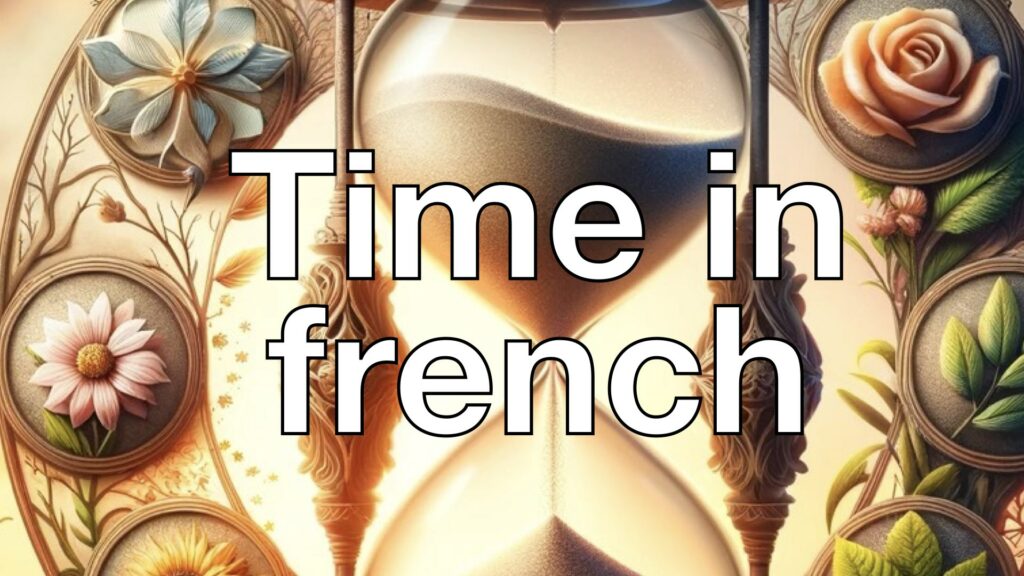Lesson: Telling Time in French
Introduction
It is very useful to understand times: at the train station, for example, you cannot rely too much on the time indicated on the smartphone application since the trains never arrive on time as everyone knows. More seriously, knowing how to tell the time is one of the essential elements of conversation. First of all, let’s note that we do not use “p.m” and “a.m” in French. We prefer to say express time over 24 hours in a formal or professional situation, and over 12 hours in an informal situation by adding “du matin / du soir” when there is a risk of misunderstanding. Let’s now see how all this works.
Official Time (L’heure officielle)
The official time is expressed in a 24-hour format, providing exact hours and minutes.
Examples:
- 23h50 is said as “vingt-trois heures cinquante.”
- 16h30 is expressed as “seize heures trente.”
This format is straightforward, reading the numbers as they appear.
Common Time (L’heure courante)
Common time relies on a 12-hour clock, often rounding off to the nearest notable marker, such as quarters or half hours.
Examples:
- 23h50 is commonly said as “minuit moins dix” (ten minutes to midnight).
- 16h30 translates to “quatre heures et demie” (four thirty).
Comparative Table: Official Time vs. Common Time
| Official Time | Common Time |
|---|---|
| 01:00 | une heure |
| 01:15 | une heure et quart |
| 01:30 | une heure et demie |
| 01:40 | deux heures moins vingt |
| 01:45 | deux heures moins le quart |
| 02:00 | deux heures |
Minutes are often rounded to express common time more conveniently.
🍀 Activities 🍀
🔷 Exercise 1: Convert Official to Common Time
Convert the following official times to common time:
- 13h15
- 14h40
- 12h30
- 0h45
- 0h15
- 16h20
🔷 Exercise 2: Read the Following Times in Official and Common Time
- a. 8h45 -> huit heures quarante-cinq / neuf heures moins le quart.
- b. 9h30 -> neuf heures trente / neuf heures et demie.
- c. 10h20 -> dix heures vingt.
- d. 11h15 -> onze heures quinze / une heure et quart.
- e. 00h00 -> zéro heure ou minuit / minuit. f. 12h00 -> douze heures ou midi / midi.
how to ask the time in french
Here are several phrases that will allow you to ask the time in French.
- Quelle heure est-il ? What time is it? ( formal )
Telling the Time
To tell the time in response, the structure is quite simple. You start with “Il est…” followed by the hour and the minutes.
Examples:
- Il est une heure. It’s one o’clock.
- Il est deux heures. It’s two o’clock.
- Il est trois heures cinq. It’s three o five.
- Il est quatre heures et demie. It’s four thirty.
- Il est cinq heures quinze. It’s five fifteen.
- Il est six heures moins le quart. It’s quarter to six.
Note that for midday and midnight, you can use:
- Il est midi. It’s noon.
- Il est minuit. It’s midnight.
- Il est midi dix. It’s ten past twelve.
- Il est midi et quart. It’s a quarter past twelve.
- Il est midi moins le quart. It’s a quarter to twelve.
- Il est midi moins vingt. It’s twenty to twelve.
- Il est minuit cinq. It’s five past midnight.
- Il est minuit et quart. It’s a quarter past midnight.
- Il est minuit et demie. It’s half past midnight.
- Il est presque midi. It’s almost noon.
- Il est presque minuit. It’s almost midnight.
Important Points:
- Half past an hour is expressed as “et demie” (and a half).
- Quarter past an hour is said as “et quart” (and a quarter).
- Quarter to an hour can be expressed as “moins le quart” (minus a quarter).
✚ Let’s Try ! Watch this video and take note.
Here are some useful expressions:
- Il est quelle heure ? What time is it?
- Vous avez l’heure, s’il vous plaît ? Do you have the time please?
- À quelle heure arrive le train ? What time does the train arrive?
- Le musée ouvre à quelle heure ? What time does the museum open?
- Ça commence à quelle heure ? What time does it start?
To go further, you can review the numbers or go to our partner site.


